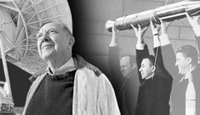
Today, Saturn and Earth find themselves almost directly opposite each other with the Sun in between, an event called conjunction. This year, conjunction occurs on August 7.
NASA's Solar and Heliospheric Observatory, known as SOHO (
http://sohowww.nascom.nasa.gov/), keeps close watch on the Sun. SOHO images show Saturn on the left moving toward the Sun, which is shielded from view but represented by a white circle in the image center. When Saturn emerges from conjunction, it will appear in SOHO images heading toward the right and away from Sun.
As Earth and Saturn play peekaboo with each other, radio communications with Cassini get very noisy, so most of Cassini's science operations are temporarily suspended. "We'll still be in constant communication," says David Doody, Cassini flight operations lead, "and we'll see the quality degrading as it nears the Sun. The last high-rate science data playback, at 14,220 bits per second, will occur Aug. 4, after which Cassini switches to low-rate telemetry downlink, at 1896 bps."
Note for sky watchers: The first time that Saturn will be visible again to the unaided eye from here on Earth will be about two weeks after conjunction. On the morning of Aug. 20, Saturn will rise in the east an hour before the sun does. Early birds in the United States will be able to spot swift Mercury one degree above Saturn. The next morning, they can spot Mercury one degree to the lower left of the planet. On Aug. 26 and 27 Saturn pairs with much brighter Venus.





